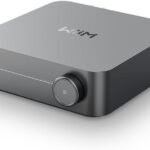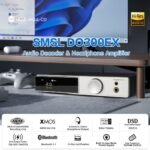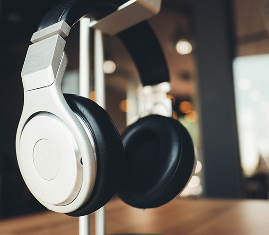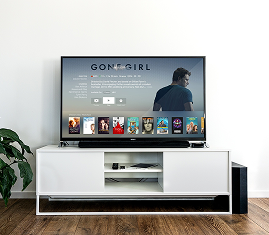Are you wondering what the differences are between open-back versus closed-back headphones? In this article, we’ll dive into the world of headphones and explore the distinctions between these two types. Whether you’re a music enthusiast or you just love a great pair of headphones, understanding the differences can enhance your listening experience.
Curious to know more? Well, stay tuned, and we’ll break it down for you. In the following paragraphs, we’ll discuss the design, sound quality, and various use cases for open-back and closed-back headphones. So, if you’ve ever pondered which type of headphones is best for you, this article will provide you with all the insights you need to make an informed decision. Let’s get started! Open-back and closed-back headphones are two distinct types of headphones that offer different experiences and cater to different needs. Understanding the differences between these two designs can help you decide when to choose the right pair of headphones for your personal preferences and requirements.
What’s the Difference Between Open-back and Closed-back Headphones?
Explaining the concept of open-back headphones
As the name suggests, Open-back headphones have an open design at the back of the ear cups. This means the ear cups have vents or grilles that allow air and sound to pass freely. The primary purpose of this design is to create a more natural and spacious sound reproduction.
The open-back design allows sound waves to escape from the ear cups, producing a more open and airy sound. This leads to a wider soundstage and better imaging, which means you can distinguish the position of instruments and sounds more accurately. It gives you a more immersive and realistic listening experience, especially in genres like classical or jazz, where soundstage and instrument separation are crucial.
Explaining the concept of closed-back headphones
On the other hand, closed-back headphones have a closed design at the back of the ear cups. This means the ear cups are entirely sealed, blocking external sounds and preventing sound leakage. Closed-back headphones are designed with isolation in mind, making them ideal for use in noisy environments or private listening sessions.
The closed-back design creates a more intimate sound experience. Sealing the ear cups prevents sound from escaping and isolates you from external noise. This results in better noise isolation, allowing you to focus on your music without being disturbed by the surrounding environment. Closed-back headphones are often favored by musicians, audio professionals, and individuals who prioritize privacy and noise isolation.
Detailed description of open-back headphone design
Open-back headphones typically feature ear cups with grilles or vents that allow sound to pass through easily. This design choice allows air to flow freely, reducing the buildup of pressure inside the ear cups. The drivers in open-back headphones are exposed to the external environment, which allows for more natural and accurate sound reproduction.
The open-back design has an impact on the bass response. Since the ear cups are not fully sealed, the bass in open-back headphones is less pronounced compared to closed-back headphones. However, open-back headphones often retrieve better detail, especially in the mid and high frequencies. This results in a more realistic and transparent sound reproduction, making them popular among audiophiles and critical listeners.
Detailed description of closed-back headphone design
Closed-back headphones, in contrast, have ear cups that are fully sealed, preventing sound from escaping and external noise from entering. The isolation of closed-back headphones makes them suitable for use in noisy environments or when privacy is essential.
The closed-back design has several advantages when it comes to bass response. The sealed ear cups allow for better bass extension and impact, resulting in more impactful and profound reproduction. The lack of sound leakage enhances the overall sound signature, providing a more focused and immersive listening experience. Closed-back headphones are often preferred by individuals who enjoy genres like EDM, hip-hop, and rock, where a strong bass presence is desirable.
Exploring the issue of sound leakage in open-back headphones
One of the primary drawbacks of open-back headphones is sound leakage. Since the ear cups have vents or grilles, sound can escape freely from the headphones. This means that people around you can hear what you are listening to, which can be pretty disruptive in quiet environments or when sharing a space with others. Open-back headphones are not recommended for public use or situations where privacy is a concern.
Examining the minimal sound leakage in closed-back headphones
In contrast, closed-back headphones have minimal to no sound leakage. The sealed ear cups prevent sound from escaping, allowing you to enjoy your music without disturbing others. This makes closed-back headphones suitable for public use, such as when commuting or working in a shared office space. Closed-back headphones offer a more immersive experience by blocking external noise and creating a private listening environment.
Discussing the impact of open-back design on sound quality
The open-back design has a significant impact on sound quality. The open nature of the ear cups allows sound waves to disperse freely, resulting in a more natural and spacious sound reproduction. The wider soundstage created by open-back headphones allows for better instrument separation and positioning. This means you can hear each instrument distinctly, enhancing the listening experience.
Open-back headphones also excel in imaging, which refers to the ability to locate sounds in a three-dimensional space. The open design provides more accurate and precise imaging, making detecting sounds coming from different directions easier. This feature is particularly beneficial for gaming, as it allows for real positional audio, giving you a competitive edge in multiplayer games.
Analyzing the sound quality of closed-back headphones
Closed-back headphones prioritize isolation and focus on providing an intimate sound experience. While the soundstage in closed-back headphones is not as wide as that of open-back headphones, they often excel in other aspects of sogooduality. The closed design enhances the bass response, creating a more impactful and immersive listening experience. The closed-back design also helps reduce outside noise interference, allowing the listener to engage with the music entirely.
Highlighting the wider soundstage and imaging in open-back headphones
One of the significant advantages of open-back headphones is their ability to create a wider soundstage. The open nature of the ear cups allows sound to disperse freely, making sense of space and depth in the audio reproduction. This wider soundstage enhances the listening experience, particularly for genres that rely on instrument separation, orchestral music, and live recordings.
In addition to a wibroaderoundstage, open-back headphones offer better imaging capabilities. Imaging refers to the ability to locate sounds accurately in a three-dimensional space. The open-back design allows for precise and accurate imaging, allowing you to pinpoint the position of each instrument or sound source. This feature makes open-back headphones particularly suitable for gaming and virtual reality applications, where accurate spatial audio is essential for an immersive experience.
Comparing the more intimate soundstage and imaging in closed-back headphones
Due to their sealed design, closed-back headphones offer a more intimate soundstage than open-back headphones. The soundstage in closed-back headphones is more focused and concentrated, resulting in a closer and more personal listening experience. This can benefit genres like pop, rock, and electronic music, where a more intimate and upfront presentation is desired.
In terms of imaging, closed-back headphones may not provide the same accuracy and precision as open-back headphones. However, they can still deliver a satisfactory imaging experience, allowing you to enjoy your music’s nuances and spatial aspects.
Examining the lack of noise isolation in open-back headphones
One of the significant drawbacks of open-back headphones is the lack of noise isolation. The open design allows sound to escape from the ear cups while also allowing outside noise to enter. This means that the ambient noise from your surroundings can interfere with your listening experience, making open-back headphones less suitable for use in noisy environments or when isolation is required.
The lack of noise isolation can be a disadvantage when you must focus on your music without distractions, such as in busy coffee shops, airplanes, or on public transportation. However, this design choice can be advantageous in certain situations, such as when you need to be aware of your surroundings, like when jogging or cycling outdoors.
Explaining the superior noise isolation in closed-back headphones
Closed-back headphones excel in noise isolation due to their sealed design. The closed-ear cups create a barrier between your ears and the outside world, blocking out external noise. This makes closed-back headphones preferred for individuals who value a quiet and immersive listening experience.
The superior noise isolation provided by closed-back headphones allows you to enjoy your music without being disturbed by background noise or other distractions. Whether you are commuting, working in a noisy office, or want to create a personal listening space, closed-back headphones offer a reliable solution.
Considering the comfort and breathability of open-back headphones
Open-back headphones often prioritize comfort and breathability. The open design allows for better airflow, preventing heat and moisture buildup around your ears during long listening sessions. This feature can significantly enhance comfort, especially in warmer climates or when using headphones for extended periods.
The breathability of open-back headphones also reduces the feeling of pressure and fatigue that can occur with closed-back headphones. The open design allows air to pass through, providing a more natural and comfortable listening experience.
Discussing the comfort and ventilation features of closed-back headphones
Closed-back headphones also prioritize comfort and often incorporate features to enhance the listening experience. While closed-back headphones may not provide the same level of breathability as open-back headphones, they compensate with other comfort features.
Many closed-back headphones have padded ear cups and headbands, ensuring a comfortable fit even during long listening sessions. Some closed-back headphones also incorporate advanced ventilation systems that help dissipate heat and prevent sweat buildup, providing a more comfortable experience in warmer environments.
Exploring the suitable applications and scenarios for using open-back headphones
Open-back headphones are well-suited for specific applications and usage scenarios. Due to their wider soundstage and accurate imaging, audiophiles and individuals who prioritize critical listening often favor them. Open-back headphones are particularly suitable for genres like classical, jazz, and acoustic music, where soundstage and instrument separation play a significant role.
Open-back headphones are also famous for individuals who enjoy gaming or virtual reality experiences. The accurate positional audio and immersive soundstage enhance the gaming experience, making detecting and locating sounds in the virtual environment easier.
Identifying the appropriate applications and scenarios for using closed-back headphones
Closed-back headphones are versatile and can be used in various applications and scenarios. Due to their excellent noise isolation, they are ideal for use in noisy environments or when privacy is essential. Closed-back headphones are commonly used in offices, libraries, public transportation, and any situation where you must block out external noise and focus on your music or work.
Additionally, closed-back headphones are preferred by musicians and audio professionals during recording and monitoring sessions. The closed design prevents sound leakage, ensuring the recording is accurate and undisturbed by external noise.
Examining the price range and availability of open-back headphones
Open-back headphones are available in a wide range of price points, depending on the brand, materials used, and overall build quality. Entry-level open-back headphones can start from around $50 and go up to several hundred dollars for high-end models. The availability of open-back headphones varies based on location and demand, but they can often be found online or at specialized audio retailers.
Analyzing the price range and availability of closed-back headphones
Similarly, closed-back headphones are available in various price ranges to cater to different budgets and requirements. Entry-level closed-back headphones can start from around $30, while high-end models cost several thousand dollars. The availability of closed-back headphones is generally more widespread than open-back headphones, as they are more commonly used and demanded by consumers.
Summarizing the critical differences between open-back versus closed-back headphones
In conclusion, open-back and closed-back headphones offer unique listening experiences and cater to different needs. Open-back headphones provide a more natural and spacious sound reproduction, with a wider soundstage and better imaging. They are ideal for critical listening, genres prioritizing soundstage and instrument separation, and gaming or virtual reality applications.
On the other hand, closed-back headphones excel in noise isolation and provide a more intimate and focused listening experience. They are suitable for use in noisy environments, private listening sessions, and genres that emphasize a strong bass presence.
When selecting the right headphones for your needs, consider factors such as sound quality, comfort, noise isolation, and the intended usage scenarios. By understanding the differences between open-back and closed-back headphones, you can make an informed decision and enjoy your music in the best possible way.










